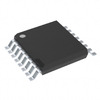Manufacturer Part Number
MAX3221ECPWR
Manufacturer
Texas Instruments
Introduction
The MAX3221ECPWR is a serial port transceiver from Texas Instruments designed for RS232 communication with a single driver/receiver pair.
Product Features and Performance
Supports RS232 protocol communication
Full duplex capability
Integrated receiver with 500 mV hysteresis for improved noise rejection
Capable of data rates up to 250kbps
Low supply voltage range from 3V to 5.5V catered for various design needs
Operates optimally across a standard industrial temperature range of 0°C to 70°C
Product Advantages
Enhanced ESD protection
Low voltage operation suitable for battery-operated applications
Low power consumption for effective power management
Key Technical Parameters
Number of Drivers/Receivers: 1/1
Duplex: Full
Receiver Hysteresis: 500 mV
Data Rate: 250kbps
Voltage Supply: 3V to 5.5V
Operating Temperature: 0°C to 70°C
Quality and Safety Features
Built with Texas Instruments' reliability and adherence to industry safety standards
Compatibility
Compatible with RS232 communication protocols
Surface mount design fits well with modern PCB technology
Application Areas
Consumer electronics
Telecommunications
Industrial control systems
Portable/Battery-powered devices
Product Lifecycle
Active product status signifying current production with continued manufacturer support
No indication of nearing discontinuation
Upgrades or replacements are typically available from Texas Instruments
Several Key Reasons to Choose This Product
High reliability and quality from a trusted manufacturer, Texas Instruments
Full duplex communication capability enables simultaneous transmission and reception
Designed to function efficiently with lower voltage power supplies, preserving energy
Optimal for integrated designs due to surface mount 16-TSSOP package
Strong ESD protection reduces risk of damage during handling and operation
The 250kbps data rate is suitable for a variety of standard communication needs
500 mV receiver hysteresis provides a robust solution to noise-prone environments




 MAX3221ECTE+Maxim
MAX3221ECTE+Maxim MAX3221ECPWTexas Instruments
MAX3221ECPWTexas Instruments MAX3221ECUE+Analog Devices Inc./Maxim IntegratedIC TRANSCEIVER FULL 1/1 16TSSOP
MAX3221ECUE+Analog Devices Inc./Maxim IntegratedIC TRANSCEIVER FULL 1/1 16TSSOP